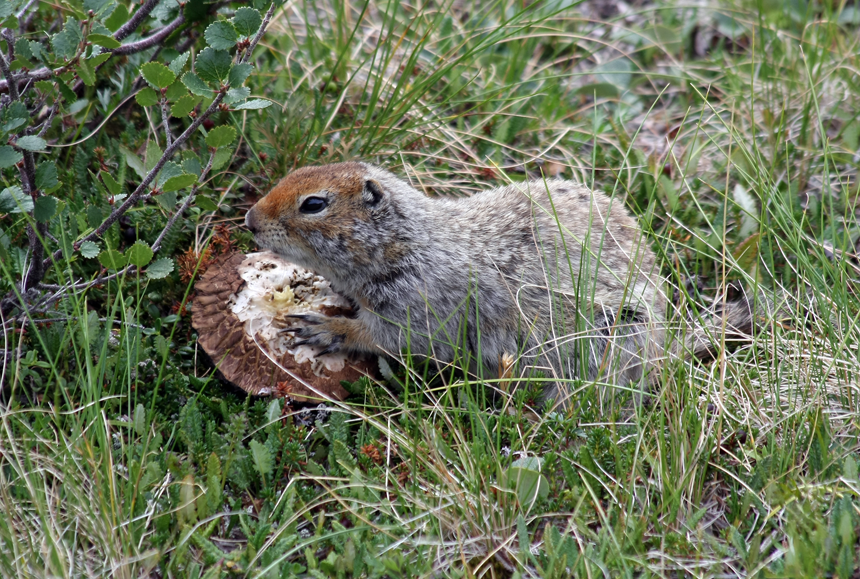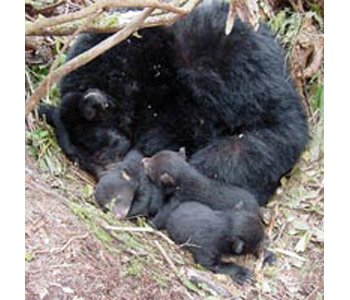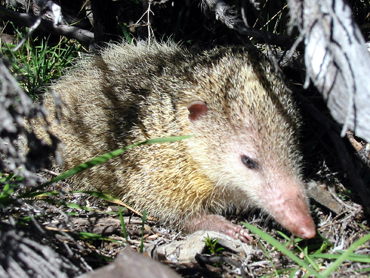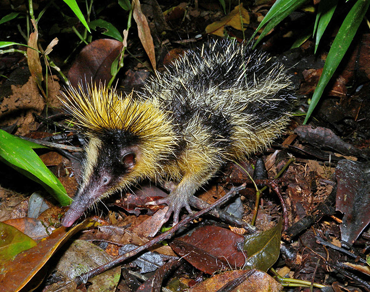Hibernation: Secrets of the big sleep
Scientists study how animals hibernate and how doing so might benefit people

This arctic ground squirrel is feeding to fatten up. In the fall, it will descend into its burrow and hibernate, letting its body temperature drop below freezing. Through that period, it will continue to slowly live off of its stored energy.
Ianaré Sévi/Wikimedia Commons/CC-BY-SA 3.0
In the far North, well above the Arctic Circle in Alaska, ground squirrels are curled into furry little balls within burrows deep underground. If you glanced at one, you might think it was dead. The squirrel is as cold as ice — literally. Its body temperature is -2° Celsius (28° Fahrenheit). Its heart beats only once every 15 seconds. Its breathing stops for minutes at a time.
It’s not dead, of course — just hibernating.
But spring is on its way to Alaska.
As the days lengthen and the surrounding ground warms, the Arctic ground squirrel will warm, too. At first, the increase will be almost too small to notice.
“You see them begin to breathe a little more quickly — see their heart rate speed up,” says Brian Barnes. He’s a zoologist, someone who studies animals, at the University of Alaska in Fairbanks (UAF). “As they get up to 10 to 20 °C [50 to 68 °F] you see them shivering quite violently,” he notes, “just as we shiver.” This shivering is a type of thermogenesis — a way to create heat. Once their bodies rise above 30 °C (86 °F), he says, “they wake up, groom themselves, stretch and scratch.” A squirrel that looked near the grave a few hours before is now very much alive.
Arctic ground squirrels are among the world’s coolest hibernators. Chilling out for months at a time lets them thrive in this frigid climate, where food scarce. By studying how these and other mammals hibernate, scientists hope to answer some big questions. Among them: How do these animals go from warm to cold and back again, undamaged? And might people ever do the same ?
The ability to chill out could help humans survive brain injuries and heart attacks. Hibernation might even be part of our ticket to Mars — if only we could figure out how to do it.
Super cool squirrels
Hibernation is a state of long-term torpor. When an animal goes into torpor, its activity level takes a dive. Its body temperature drops. The animal also slows its metabolism — the chemical reactions happening in all of its cells that keep the animal alive. Some animals might go torpid for a day. Or two. Or three.
When torpor lasts longer than just a few days, scientists call it hibernation. Many people think hibernation occurs because it’s cold. But it’s not just a winter thing.
“The purpose of hibernation is energy conservation,” explains Kelly Drew. She’s a UAF neuroscientist, someone who studies the brain. Cooling down is a consequence of saving energy, she says, like “turning down the pilot light or resetting the thermostat.”
Cooling down might sound easy. But preparing for it is hard work.
“These guys basically eat all fall,” notes Sarah Rice. She’s a UAF graduate student in neuroscience in Drew’s laboratory. With all of that eating, the squirrels get fat — so fat they can double in size. The males also collect berries, seeds, mushrooms and leaves, then store them in their burrows.
As fall approaches, the squirrels’ brains begin to release large amounts of a chemical messenger. The scientists still don’t know exactly which chemical it is. Eventually, however, it enters a docking molecule in a cell that helps relay messages. Called the adenosine (Ah-DEN-oh-seen) A1 receptor, it’s the same one that people try to block by drinking coffee. Doing so helps keep us awake. But when the right chemical messenger enters, like a key, it unlocks the opposite effect — sleepiness. By August or September, the squirrels settle into their burrows and their body temperatures and metabolisms begin to drop.
In time, these animals fall into hibernation. Most of their body functions stop. They don’t pee or poop. They won’t drink or eat. Cells in their brains begin to retract their connecting parts. Their blood flow drops by as much as 90 percent, depriving their bodies of oxygen. If blood flow dropped by the same amount in people, we would be dead in minutes. But the squirrels can do it year after year.
“These small hibernators can survive having their brains essentially turned off at these low temperatures,” Barnes says. By turning off so many other bodily functions, the squirrels drop their metabolic rate by up to 90 percent. That saves a huge amount of energy — which means they need fewer calories to survive. That’s one way they get by without eating throughout this period.
These animals won’t emerge from their burrows until April. The males start to stir first. During the winter, their metabolism gets too low to allow male squirrels to produce sperm. So they don’t. Instead, every spring, arctic ground squirrels become teens again as they exit hibernation. They stay in their burrows for a few weeks, dining on their previously stored food and going through puberty (having fur, however, they probably don’t get zits). When they are finally ready to leave, these males are also ready to mate. And then it’s time to start fattening up again for the fall.
But a hibernating squirrel doesn’t spend the whole winter motionless and cold. “The weird thing about hibernation is they have this rhythmic arousal on a very regular schedule,” Rice says. “Depending on the squirrel, it can be every 14 to 21 days. They rouse up and they make immune cells and gain normal brain function.” During these arousals, their bodies shiver their way back to around 37 °C (98.6 °F). Now the animals will bumble around, stretch, roll over — then go to sleep. After about a day, their body temperatures will again plummet. This makes them turn torpid and resume hibernation.
Story continues below video
Alaskanrose1
Those arousals take a lot of energy. Indeed, they’ll use up most of the calories that the squirrels’ bodies had stored for the winter as fat. So there must be a reason why they do it. For now, though, no one knows what it is. “There’s probably 20 different [ideas] about why they do it,” Drew says. Maybe something bad would happen if the animals didn’t rewarm. They might need to get rid of waste products or make sugar from their stored fat.
Right now, Drew’s lab is trying to find out what temporarily arouses the hibernating the squirrels. “If we understood what the cue was,” she says, “how the body is telling them to warm up, then we’d be able to manipulate it.” Why do that? If scientists could control whether a squirrel aroused or not, she explains, they might be able to figure out what makes the rhythmic arousals so important.
Keeping bear bones bulky
Squirrels are far from the only mammals that take a timeout in winter. Black bears spend six months of the year “denning” — curled up without eating, drinking or peeing. Oh, and the bears develop an anal plug. Called a tappen, it’s made out of hard fibrous material. And its purpose? To keep any poop in, and other things (like, um, bugs) out during the long rest period.

As bears hibernate, their metabolism can fall by up to half. Unlike ground squirrels, however, bears keep their body temperature at around 30°C (86°F).
Because the bears stay so relatively warm, some scientists question whether bears truly hibernate. Some male black bears don’t even bother denning down in the winter. And if disturbed by people in winter, bears will rouse and even abandon their den.
Barnes, however, has no doubts that bears hibernate. “They get fat and seclude themselves away. They do drop their metabolism. It’s the only way you can get away without eating,” he explains. They’re so big and well-insulated, he notes, that they can slow down their metabolism enough to drop their energy use by 75 percent.
For six months, these bears barely move. “They are able to stay [lying down] for weeks at a time,” Barnes observes. “They do move every couple of days.” For instance, they may roll over to rest on their other side. If people remained this still for weeks or months, their bones would waste away, or atrophy (AA-troh-fee). But bears trundle out of their dens in spring none the worse for that long rest.
How do they do it? Bones might seem very solid, but the tissue within them is always being replaced. Older bone is broken down by osteoclasts (OS-tee-oh-klasts) — cells that can break down and absorb bone tissue. Cells called osteoblasts build new bone.
When people don’t move for long periods, their osteoblasts work more slowly and their osteoclasts work faster. This weakens bones. Hibernating bears decrease many of their physical functions, but bone is worth preserving. Genes, the molecules that control the actions of a cell, help boost osteoblast activity in hibernating bears, Barnes’ lab has shown. At the same time, genes that help form osteoclasts slow down. This helps keep a bear’s bones buff until spring.
“We don’t know how” a bear’s skeleton is able to do this, Barnes says. But understanding this might help scientists fight human diseases such as osteoporosis — when bones thin, weaken and turn brittle.
Story continues below video
Minnestoa DNR
The trouble with tenrecs
Ground squirrels chill out and bears don’t move for months. But for a really strange hibernator, meet a tenrec or two.
These mammals are native to Madagascar. They arrived on this island nation off of the East Coast of Africa between 42 million and 25 million years ago. Over time, they spread out and evolved into 34 different species. Thirty-one of them stayed on the island; the rest migrated to the African mainland.

“There’s a whole bunch of variation” among these animals, observes Frank van Breukelen. This biologist studies tenrecs at the University of Nevada in Las Vegas. “Some look like hedgehogs — some like rats, mice, otters. Some look like space aliens!” Certain of their species live in trees. Others live on the ground. Some tenrecs even live part-time in water. Different species of tenrec come in different sizes. Some types are less than five centimeters (around 2 inches), others around six times that size.
These mammals have another odd feature: They are curiously unconcerned about holding their body temperature constant. The human body tries to hold its temperature to within a couple of degrees of 37 °C (98.6 °F), notes Sandy Martin. She studies hibernation at the University of Colorado School of Medicine in Aurora. Tenrecs, in contrast, want their body temperatures around 32 or 33 °C (89 to 91 °F). But they don’t seem at all bothered if it goes up or down by some five degrees Celsius. If people did the same, our temperatures would fluctuate wildly between 32 and 42 °C (89 and 107 °F), putting us at constant risk of death.
This relaxed attitude toward body temperature extends to how tenrecs hibernate. They may go into torpor at body temperatures that seem quite high, up to 28 °C (82 °F). But they also can be active at body temperatures as low as 12 °C (54 °F). At that temperature, the human body would be clinically dead (although a few people have been resuscitated from a few degrees Fahrenheit warmer than that).
How do tenrecs manage this? Nobody knows. But van Breukelen is determined to find out. To understand hibernation, scientists should study more animals than just ground squirrels, he argues. “It’s sort of like saying if you want to study human performance, you should look at Usain Bolt,” he says. The Arctic ground squirrel is the Usain Bolt of hibernators — the best hibernator out there. Van Breukelen likens tenrecs, in contrast, to some Homer Simpson of the hibernation world. “They’re not good at it, but it works.” By studying how tenrecs hibernate — and what they might have in common with ground squirrels — he hopes to figure out what allows certain mammals to hibernate.
Hibernation at the bedside and beyond
The ability of a ground squirrel, a bear or a tenrec to hibernate might seem like nothing more than a weird biological quirk. But that quirk has given these species huge survival benefits — ones that scientists like Drew hope to take advantage of.
As a ground squirrel slips into torpor, its body parts get less and less blood flow. That means its tissues also get less and less oxygen. Blood flow to the squirrel’s brain slows by as much as 99 percent. Most animals would never survive such a low blood flow, but ground squirrels do. By finding out what makes them so resilient, Drew hopes to be able to transfer that quality to people.

The squirrels appear to survive such low flow by keeping their cool. “A lot of people thought it was something special about the hibernating state,” Drew says. But scientists have learned that a big chill — a really dramatic one — helps protect the squirrels during periods of low oxygen levels in blood.
People, like squirrels, might also benefit from chilling out. When blood flow to the heart stops, a person can develop a heart attack. That’s where the heart muscle stops pumping blood, starving some tissues of enough oxygen that they die. The victim might even end up in a coma. But keeping this patient’s body temperature cooler than normal while they are comatose, between 32 and 36 °C (90 to 97 °F), might improve their recovery. When doctors cool a patient slightly, this way, it’s called targeted therapeutic hypothermia.
In stroke patients, blood flow is cut off to a part of the brain. Drew hopes that cooling those patients might help them as well. But that, she says, is “still in the research stage.”
There are many other times when blood flow to the heart and brain drops. Anytime someone has heart or brain surgery, Martin says, blood flow gets interrupted and cells may suffer. Cooling the patient might help avoid extra damage.
And hospitals are not the only place where hibernation might benefit people. Drew is working with a team at SpaceWorks Enterprises to find ways to help people hibernate — in space.
A key to space travel?
“Everyone thinks it’s going to be the only way to get humans into deep space,” Martin says of hibernation.
“The problems of maintaining humans in their normal active state [in space] are huge.” Space travelers would need to eat and drink. They’d make waste and have to put it somewhere. Without gravity, people in space for long periods of time would see their bones and muscles waste away. And if a small group of space travellers were stuck in close quarters for months or even years, Martin worries about another risk: people getting on each other’s nerves!

If astronauts could instead be coaxed into torpor, Martin says, “then all these problems go away.” Astronauts wouldn’t eat, drink or produce wastes. If they could den like bears, they might not lose muscle and bone mass. They wouldn’t bug each other, either.
The idea of hibernating during space travel is so trendy that it shows up in blockbuster movies such as 2016’s Passengers. But if scientists succeed in triggering astronauts to hibernate, Martin says, people back home would likely also benefit.
When it comes to application of human hibernation, “I would argue space might be the least important,” she says. Why? Few of us will ever leave Earth. Yet for even regular surgeries, she suspects, inducing torpor “could be extremely useful to lower body temperature and metabolic rate … [and help] in everyday medicine.”
“Certainly, in routine surgeries it could be extremely useful to lower body temp and metabolic rate,” she says. In future, she suspects, cooling patients may turn out to have many benefits in every day medicine.
But there’s one big catch. “We don’t have the secret which would allow me to make you hibernate,” Martin points out. Still, with all the benefits it might have for health and human space travel, researchers will definitely keep looking for ways to offer humans the chance to hibernate, too.







